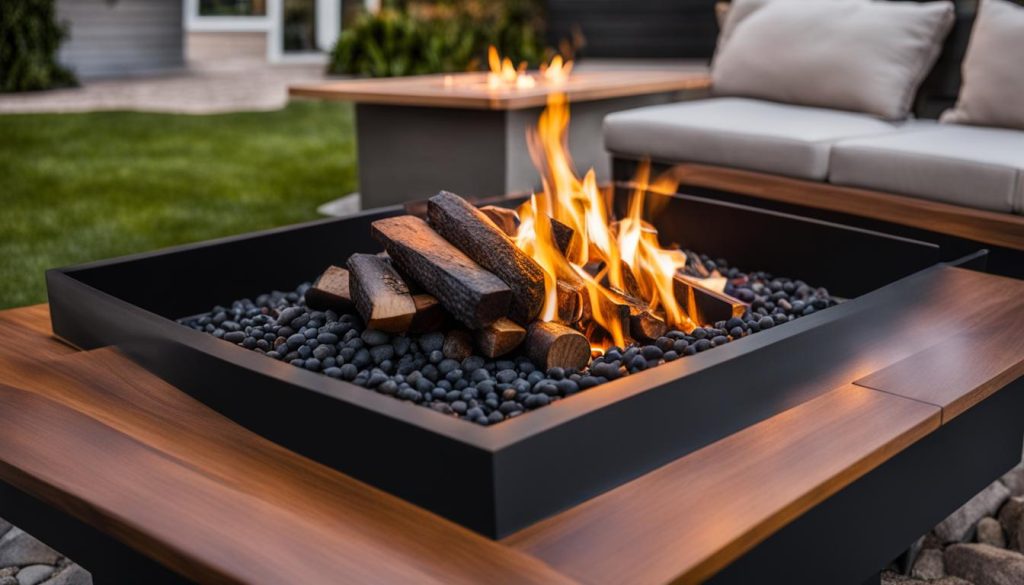What to Burn in Firepit Table: Best Options for Your Backyard Fun

Table of Contents
When it comes to enhancing your backyard experience, a firepit table is the perfect addition. Gathering around a warm and cozy fire, roasting marshmallows, and enjoying the company of friends and family creates unforgettable memories. But what should you burn in your firepit table to ensure a safe and enjoyable experience? Let’s explore the best fuel options and burning materials for your firepit table.
Key Takeaways:
- Choosing the right fuel for your firepit table is essential for safety and enjoyment.
- Wood, propane, natural gas, and bio-ethanol are popular fuel options.
- Hardwoods like oak and maple provide a steady heat source with less smoke.
- Propane and natural gas offer convenience and clean-burning properties.
- Bio-ethanol is a green fuel choice with minimal emissions.
Best Types of Wood to Burn in Your Fire Pit
When it comes to choosing the best wood for your firepit table, there are a few factors to consider. Hardwoods such as oak, maple, and hickory are excellent options. They burn hot and slow, providing a steady source of heat for your outdoor gatherings. These hardwoods also produce less smoke compared to softwoods, resulting in a more enjoyable experience.
Softwoods like pine and cedar are easier to ignite but tend to produce more smoke and burn less efficiently. While they can still be used in firepit tables, be prepared for more frequent refueling and a smokier ambiance. Fruitwoods like apple and cherry can be a great choice if you plan on cooking over the fire, as they can infuse a delightful flavor into your food.
It’s crucial to avoid using treated woods and coniferous woods such as pine and spruce in your firepit table. Treated woods may contain harmful chemicals that can be released when burned, posing a risk to your health and the environment. Coniferous woods tend to produce excessive smoke, which can be bothersome and affect your overall enjoyment of the firepit experience.
Using Propane in Your Firepit Table
Propane is a popular choice for fueling firepit tables due to its convenience and clean-burning properties. It offers a hassle-free experience as it comes in tanks that can be easily refilled or replaced, ensuring that you always have a steady fuel source. Propane burns efficiently, providing a reliable and consistent heat output for your firepit.
One of the advantages of using propane is its ease of use. Lighting a propane firepit table is as simple as turning a knob or pressing a button, eliminating the need for any additional fire-starting materials. This makes it a convenient option for those who want a quick and hassle-free firepit experience.
Ensuring Safety
While propane is generally safe to use, it’s important to ensure proper ventilation when using a propane firepit table. Propane is a compressed gas, and if not handled properly, it can pose a safety risk. Ensure that your firepit table is placed in a well-ventilated area, allowing any potentially hazardous gas to disperse safely.
When handling propane tanks, always follow the manufacturer’s instructions and guidelines. Ensure that the tanks are stored in a secure and upright position, away from any sources of heat or open flames. Regularly inspect the tanks for any signs of damage or leakage and replace them if necessary.
Considerations for Propane
When choosing propane as the fuel for your firepit table, it’s important to consider a few factors. The size of the propane tank will determine how long it will last before needing a refill or replacement. If you plan on using your firepit frequently, you may want to opt for a larger tank or consider having a backup tank on hand.
Another consideration is the cost of propane. While propane is generally affordable, the cost can vary depending on your location and the availability of propane in your area. It’s worth researching local propane prices and suppliers to ensure you’re getting the best value for your money.
In summary, propane is a convenient and clean-burning fuel option for your firepit table. It provides a hassle-free experience and a steady heat source. However, proper ventilation and safety precautions should always be taken when using propane. Consider the size and cost of propane tanks to ensure you have an uninterrupted firepit experience.
Utilizing Natural Gas in Your Firepit Table
When it comes to choosing the fuel for your firepit table, one option to consider is natural gas. Natural gas offers several advantages, making it a popular choice for many homeowners. One of the key benefits of using natural gas is its clean-burning properties. Unlike other fuel options, natural gas produces minimal smoke and soot, creating a more enjoyable and hassle-free experience.
In addition to being clean-burning, natural gas provides a continuous fuel source without the need for refilling. Once you have a gas line installed, you can enjoy the convenience of uninterrupted fires in your firepit table. This can be particularly beneficial if you plan on using your firepit frequently or for extended periods of time.
However, it’s important to weigh the cost and environmental impact of using natural gas. While natural gas is cost-effective in the long run, the initial installation of a gas line can be a significant investment. Additionally, natural gas is a fossil fuel, and its extraction and use contribute to greenhouse gas emissions. Proper venting is also crucial to ensure the release of any harmful pollutants.
Exploring Bio-Ethanol as a Fuel Option
If you’re looking for a clean-burning and environmentally friendly fuel option for your firepit table, you may want to consider bio-ethanol. Bio-ethanol is derived from plant sources and produces little to no smoke or soot when burned. This makes it an ideal choice for those who are sensitive to smoke or live in areas with shifting breezes.
In addition to its clean-burning properties, bio-ethanol fire pits have high fuel efficiency rates. This means that you can enjoy longer burn times and maximize the use of your fuel. Furthermore, bio-ethanol emits lower greenhouse gas emissions compared to fossil fuel equivalents, making it a greener choice.
However, it’s important to note that bio-ethanol may generate less heat compared to other fuel options. This means that it may not provide the same level of warmth as wood, propane, or natural gas. Additionally, bio-ethanol can be more expensive than other fuels, so it’s important to consider your budget when making your decision.
Exploring Bio-Ethanol as a Fuel Option for Your Firepit Table
If you’re looking for a clean-burning and environmentally friendly fuel option for your firepit table, bio-ethanol may be the perfect choice. Derived from plant sources, bio-ethanol produces little to no smoke or soot, making it ideal for outdoor spaces where shifting breezes can be a concern or for individuals with sensitivity to smoke. Unlike fossil fuels, bio-ethanol fire pits have high fuel efficiency rates and emit lower greenhouse gas emissions.
One of the advantages of bio-ethanol is its ease of use. It comes in liquid form and can be easily poured into the firepit, eliminating the need for handling or storing heavy tanks. Bio-ethanol fire pits also offer the convenience of adjustable flame heights, allowing you to control the heat output according to your preference.
However, it’s important to note that bio-ethanol may generate less heat compared to other fuel options such as wood or propane. If you’re primarily looking for a heat source, hardwoods like oak or maple might be a better choice. Additionally, bio-ethanol can be more expensive than other fuels, so it’s worth considering the cost aspect as well.
Summary
Bio-ethanol provides a clean-burning and environmentally friendly fuel option for your firepit table. It produces minimal smoke and soot, making it suitable for spaces with shifting breezes or individuals sensitive to smoke. Bio-ethanol fire pits have high fuel efficiency rates and emit lower greenhouse gas emissions compared to fossil fuel equivalents. While bio-ethanol offers ease of use and adjustable flame heights, it may generate less heat and be more expensive than other fuel options.
Factors to Consider When Choosing Firepit Table Fuel
When it comes to selecting the fuel for your firepit table, it is important to consider various factors to ensure a safe and enjoyable experience. The fuel you choose will impact the heat output, burn time, cost, safety considerations, ease of use, and fuel availability. By evaluating these factors, you can make an informed decision that suits your specific needs and preferences.
Heat output is a crucial factor to consider. Different fuels have varying heat levels, so it’s essential to choose one that provides the desired level of warmth for your outdoor gatherings. Burn time is another important consideration. Some fuels burn more quickly than others, so consider how long you want the fire to last and choose a fuel that aligns with your preferences.
Cost is a practical aspect to factor in. Some fuels may be more expensive than others, so consider your budget and choose a fuel that offers the right balance between cost and desired features. Safety is always a priority, so be sure to choose a fuel that poses minimal risks and follow the necessary safety guidelines when using your firepit table.
Ease of use and fuel availability are also important factors. Consider how easy it is to procure and store the fuel for your firepit table. Some fuels may require special equipment or refilling, while others may be readily available for purchase. Choose a fuel that aligns with your convenience and accessibility preferences.
Conclusion
When it comes to choosing the fuel for your firepit table, you have several options to consider. The best fuel options for your firepit table include hardwoods, propane, natural gas, and bio-ethanol.
Hardwoods like oak, maple, and hickory provide a steady heat source and less smoke, making them ideal for a cozy and enjoyable firepit experience. Propane and natural gas offer convenience and clean-burning properties. Propane is easily available in refillable tanks, while natural gas provides a continuous fuel source once installed. Both fuels ensure a comfortable and hassle-free firepit experience.
If you’re looking for a green fuel choice, bio-ethanol is derived from plant sources and offers minimal emissions. It produces little to no smoke or soot, making it a great option for those with sensitivity to smoke or areas with shifting breezes. However, bio-ethanol may generate less heat and can be more expensive compared to other fuel options.
When making your decision, consider factors such as heat output, burn time, cost, safety, ease of use, and fuel availability. These factors will help you select the fuel that best fits your needs and preferences. Whether you prefer the warmth and ambiance of hardwoods, the convenience of propane or natural gas, or the eco-friendliness of bio-ethanol, there’s a fuel option out there for you to enjoy your firepit table to the fullest.
FAQ
What are the best options for fueling a firepit table?
The best options for fueling a firepit table include wood, propane, natural gas, and bio-ethanol.
Which types of wood are recommended for burning in a firepit table?
Hardwoods such as oak, maple, and hickory are the best options for burning in a firepit table.
What are the advantages of using propane in a firepit table?
Propane is easy to use, burns efficiently, and produces a steady heat source.
What are the benefits of using natural gas as a fuel for a firepit table?
Natural gas is odorless, burns cleanly, and provides a continuous fuel source without the need for refilling.
What is bio-ethanol and why is it a good fuel option for firepit tables?
Bio-ethanol is derived from plant sources and offers a clean-burning fuel option. It produces little to no smoke or soot and has lower greenhouse gas emissions compared to fossil fuel equivalents.
What factors should I consider when choosing the fuel for my firepit table?
Factors to consider include desired heat output, burn time, cost, safety considerations, ease of use, and fuel availability.
Share:
More Posts



